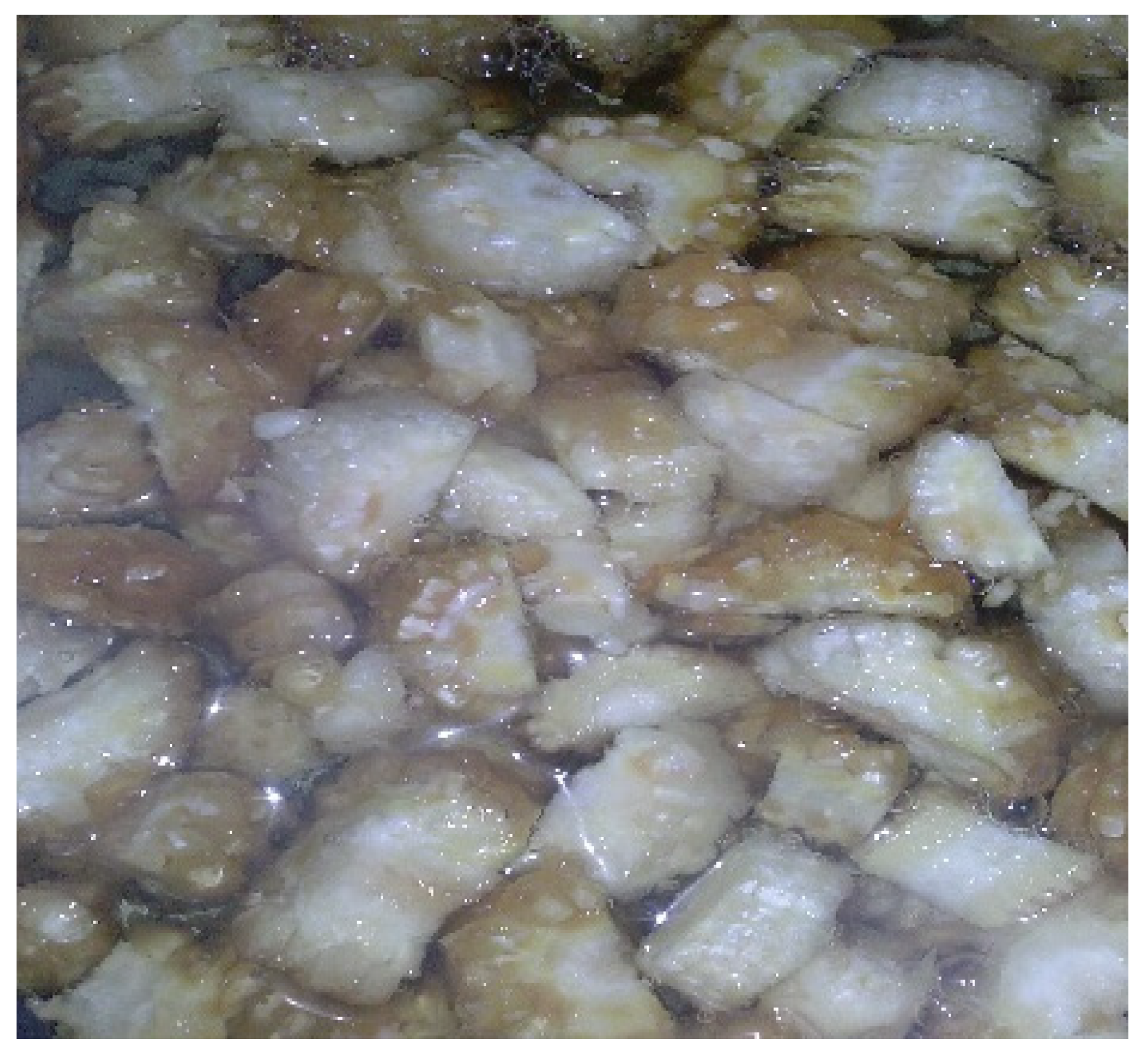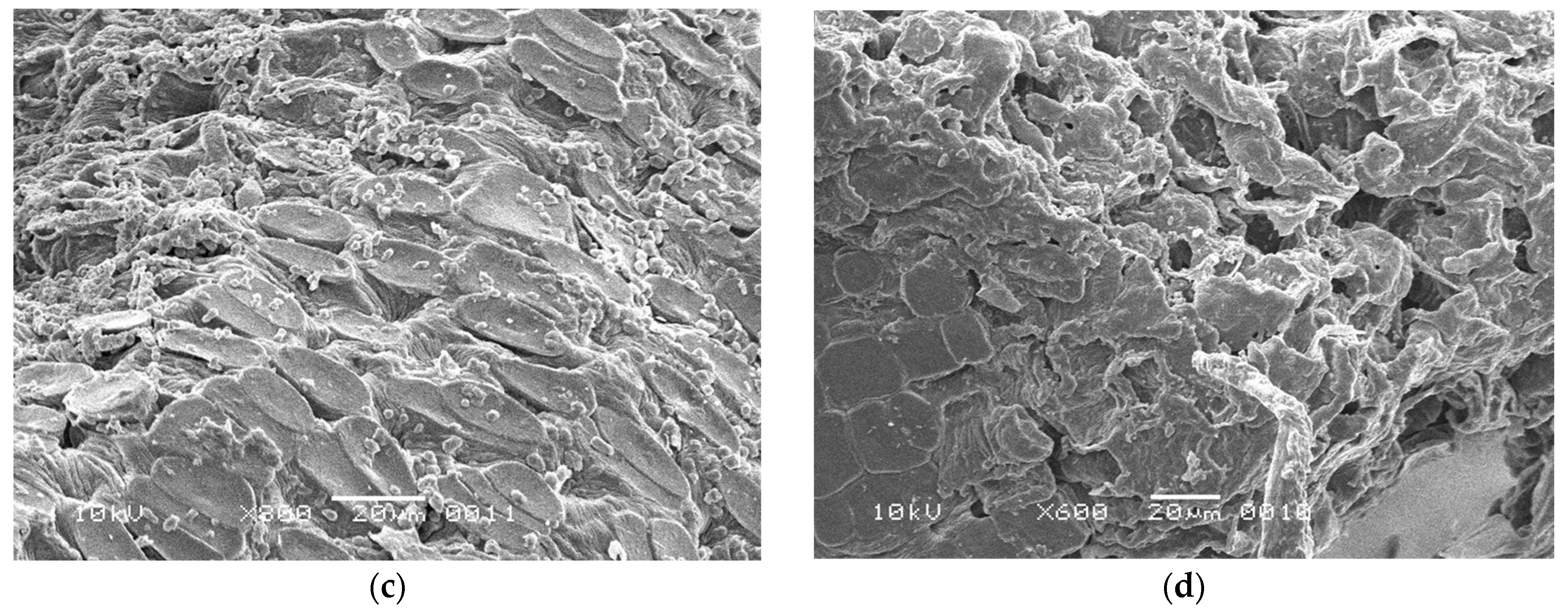Utilization of Corncob as an Immobilization Matrix for a Xylanolytic Yeast Strain
Abstract
:1. Introduction
2. Materials and Methods
2.1. Inoculum Preparation
2.2. Effect of Media Composition on Xylanase Production
2.3. Xylanase Assay
2.4. Pretreatment of Corncob
2.5. Immobilization on Corncob
2.6. Xylanase Production from Immobilized Yeast
2.7. Scanning Electron Microscopy
2.8. Collection of Bagasse and Its Pretreatment
2.9. Saccharification of Bagasse by Crude Xylanase
2.10. Reducing Sugar Assay
2.11. Statistical Analysis
3. Results and Discussion
4. Conclusions
Author Contributions
Funding
Institutional Review Board Statement
Informed Consent Statement
Data Availability Statement
Acknowledgments
Conflicts of Interest
References
- Rajabi, M.; Nourisanami, F.; Ghadikolaei, K.K.; Changizian, M.; Noghabi, K.A.; Zahiri, H.S. Metagenomic Psychrohalophilic Xylanase from Camel Rumen Investigated for Bioethanol Production from Wheat Bran Using Bacillus Subtilis AP. Sci. Rep. 2022, 12, 8152. [Google Scholar] [CrossRef] [PubMed]
- Wang, J.; Liang, J.; Li, Y.; Tian, L.; Wei, Y. Characterization of Efficient Xylanases from Industrial-Scale Pulp and Paper Wastewater Treatment Microbiota. AMB Express 2021, 11, 19. [Google Scholar] [CrossRef] [PubMed]
- Mandal, A. Review on Microbial Xylanases and Their Applications. Int. J. Life Sci. 2015, 4, 178–187. [Google Scholar]
- Bhardwaj, N.; Kumar, B.; Verma, P. A Detailed Overview of Xylanases: An Emerging Biomolecule for Current and Future Prospective. Bioresour. Bioprocess. 2019, 6, 40. [Google Scholar] [CrossRef] [Green Version]
- Chen, Q.; Li, M.; Wang, X. Enzymology Properties of Two Different Xylanases and Their Impacts on Growth Performance and Intestinal Microflora of Weaned Piglets. Anim. Nutr. 2016, 2, 18–23. [Google Scholar] [CrossRef] [PubMed]
- Salari, R. Investigation of the Best Saccharomyces Cerevisiae Growth Condition. Electron. Physician 2016, 8, 3057–3061. [Google Scholar] [CrossRef] [Green Version]
- Adrio, J.L.; Demain, A.L. Microbial Enzymes: Tools for Biotechnological Processes. Biomolecules 2014, 4, 117–139. [Google Scholar] [CrossRef] [Green Version]
- Qadir, F.; Ejaz, U.; Sohail, M. Co-Culturing Corncob-Immobilized Yeasts on Orange Peels for the Production of Pectinase. Biotechnol. Lett. 2020, 42, 1743–1753. [Google Scholar] [CrossRef] [PubMed]
- Shariq, M.; Muhammad, F.; Ahmad, A.; Khan, S.A.; Moin, S.F.; Sohail, M. Production and Characterization of Endoglucanase from an Indigenous Yeast Strain. Pak. J. Bot. 2018, 50, 2413–2421. [Google Scholar]
- Moreno-García, J.; García-Martínez, T.; Mauricio, J.C.; Moreno, J. Yeast Immobilization Systems for Alcoholic Wine Fermentations: Actual Trends and Future Perspectives. Front. Microbiol. 2018, 9, 241. [Google Scholar] [CrossRef] [PubMed] [Green Version]
- Kanojia, V.; Rouf, A.; Naik, H.R. Cell Immobilization: An Overview on Techniques and Its Applications in Food Industry. Int. J. Chem. Stud. 2017, 5, 1817–1824. [Google Scholar]
- Lee, S.E.; Lee, C.G.; Kang, D.H.; Lee, H.Y.; Jung, K.H. Preparation of Corncob Grits as a Carrier for Immobilizing Yeast Cells for Ethanol Production. J. Microbiol. Biotechnol. 2012, 22, 1673–1680. [Google Scholar] [CrossRef] [PubMed] [Green Version]
- Chandel, A.K.; da Silva, S.S.; Carvalho, W.; Singh, O.V. Sugarcane Bagasse and Leaves: Foreseeable Biomass of Biofuel and Bio-Products. J. Chem. Technol. Biotechnol. 2012, 87, 11–20. [Google Scholar] [CrossRef]
- Khoo, R.Z.; Chow, W.S.; Ismail, H. Sugarcane Bagasse Fiber and Its Cellulose Nanocrystals for Polymer Reinforcement and Heavy Metal Adsorbent: A Review. Cellulose 2018, 25, 4303–4330. [Google Scholar] [CrossRef]
- Karp, S.G.; Woiciechowski, A.L.; Soccol, V.T.; Soccol, C.R. Pretreatment Strategies for Delignification of Sugarcane Bagasse: A Review. Braz. Arch. Biol. Technol. 2013, 56, 679–689. [Google Scholar] [CrossRef]
- Chambon, C.L.; Mkhize, T.Y.; Reddy, P.; Brandt-Talbot, A.; Deenadayalu, N.; Fennell, P.S.; Hallett, J.P. Pretreatment of South African Sugarcane Bagasse Using a Low-Cost Protic Ionic Liquid: A Comparison of Whole, Depithed, Fibrous and Pith Bagasse Fractions. Biotechnol. Biofuels 2018, 11, 247. [Google Scholar] [CrossRef] [PubMed] [Green Version]
- De Guilherme, A.A.; Dantas, P.V.F.; Soares, J.C.J.; Dos Santos, E.S.; Fernandes, F.A.N.; De Macedo, G.R. Pretreatments and Enzymatic Hydrolysis of Sugarcane Bagasse Aiming at the Enhancement of the Yield of Glucose and Xylose. Braz. J. Chem. Eng. 2017, 34, 937–947. [Google Scholar] [CrossRef] [Green Version]
- Corry, J.E.; Curtis, G.D.; Baird, R.M. Handbook of Culture Media for Food and Water Microbiology, 3rd ed.; Elsevier: Amsterdam, The Netherlands, 2011. [Google Scholar]
- Miller, G.L. Use of Dinitrosalicylic Acid Reagent for Determination of Reducing Sugar. Anal. Chem. 1959, 31, 426–428. [Google Scholar] [CrossRef]
- Rashid, R.; Ejaz, U.; Sohail, M. Biomass to Xylose. In Sustainable Bioconversion of Waste to Value Added Products; Springer: Berlin/Heidelberg, Germany, 2021; pp. 247–265. [Google Scholar]
- Amadi, O.C.; Egong, E.J.; Nwagu, T.N.; Okpala, G.; Onwosi, C.O.; Chukwu, G.C.; Okolo, B.N.; Agu, R.C.; Moneke, A.N. Process Optimization for Simultaneous Production of Cellulase, Xylanase and Ligninase by Saccharomyces Cerevisiae SCPW 17 under Solid State Fermentation Using Box-Behnken Experimental Design. Heliyon 2020, 6, e04566. [Google Scholar] [CrossRef]
- Fang, C.; Wang, Q.; Selvaraj, J.N.; Zhou, Y.; Ma, L.; Zhang, G.; Ma, Y. High Copy and Stable Expression of the Xylanase XynHB in Saccharomyces Cerevisiae by RDNA-Mediated Integration. Sci. Rep. 2017, 7, 8747. [Google Scholar] [CrossRef] [PubMed] [Green Version]
- Qinnghe, C.; Xiaoyu, Y.; Tiangui, N.; Cheng, J.; Qiugang, M. The Screening of Culture Condition and Properties of Xylanase by White-Rot Fungus Pleurotus Ostreatus. Process Biochem. 2004, 39, 1561–1566. [Google Scholar] [CrossRef]
- Bajaj, B.K.; Sharma, M.; Sharma, S. Alkalistable Endo-β-1,4-Xylanase Production from a Newly Isolated Alkalitolerant Penicillium Sp. SS1 Using Agro-Residues. 3 Biotech 2011, 1, 83–90. [Google Scholar] [CrossRef] [PubMed] [Green Version]
- Chen, C.C.; Wu, C.H.; Wu, J.J.; Chiu, C.C.; Wong, C.H.; Tsai, M.L.; Lin, H.T.V. Accelerated Bioethanol Fermentation by Using a Novel Yeast Immobilization Technique: Microtube Array Membrane. Process Biochem. 2015, 50, 1509–1515. [Google Scholar] [CrossRef]
- Berlowska, J.; Kregiel, D.; Ambroziak, W. Physiological Tests for Yeast Brewery Cells Immobilized on Modified Chamotte Carrier. Antonie Van Leeuwenhoek Int. J. Gen. Mol. Microbiol. 2013, 104, 703–714. [Google Scholar] [CrossRef] [PubMed] [Green Version]
- Pacheco, A.M.; Gondim, D.R.; Gonçalves, L.R.B. Ethanol Production by Fermentation Using Immobilized Cells of Saccharomyces Cerevisiae in Cashew Apple Bagasse. Appl. Biochem. Biotechnol. 2010, 161, 209–217. [Google Scholar] [CrossRef]
- Almeida, C.; Brányik, T.; Moradas-Ferreira, P.; Teixeira, J. Continuous Production of Pectinase by Immobilized Yeast Cells on Spent Grains. J. Biosci. Bioeng. 2003, 96, 513–518. [Google Scholar] [CrossRef] [PubMed]
- Olanbiwoninu, A.A.; Odunfa, S.A. Production of Cellulase and Xylanase by Aspergillus Terreus KJ829487 Using Cassava Peels as Subtrates. Adv. Microbiol. 2016, 6, 502–511. [Google Scholar] [CrossRef] [Green Version]
- Martos, M.A.; Zubreski, E.R.; Garro, O.A.; Hours, R.A. Production of Pectinolytic Enzymes by the Yeast Wickerhanomyces Anomalus Isolated from Citrus Fruits Peels. Biotechnol. Res. Int. 2013, 2013, 435154. [Google Scholar] [CrossRef] [Green Version]
- Nighojkar, S.; Phanse, Y.; Sinha, D.; Nighojkar, A.; Kumar, A. Production of Polygalacturonase by Immobilized Cells of Aspergillus Niger Using Orange Peel as Inducer. Process Biochem. 2006, 41, 1136–1140. [Google Scholar] [CrossRef]
- Garai, D.; Kumar, V. Response Surface Optimization for Xylanase with High Volumetric Productivity by Indigenous Alkali Tolerant Aspergillus Candidus under Submerged Cultivation. 3 Biotech 2013, 3, 127–136. [Google Scholar] [CrossRef] [Green Version]
- Zafar, H.; Rehman, I.; Ejaz, U.; Ansari, A.; Sohail, M. Production of Multienzyme by Bacillus Aestuarii UE25 Using Ionic Liquid Pretreated Sugarcane Bagasse. J. Basic Microbiol. 2021, 61, 1016–1028. [Google Scholar] [CrossRef]
- Kwon, S.W.; Jeong, B.O.; Lee, E.H.; Kim, Y.S.; Jung, Y. Conducting Polymer-Silica Composites for Immobilization of Enzymes. Bull. Korean Chem. Soc. 2012, 33, 1593–1596. [Google Scholar] [CrossRef] [Green Version]
- Genisheva, Z.; Mussatto, S.I.; Oliveira, J.M.; Teixeira, J.A. Evaluating the Potential of Wine-Making Residues and Corn Cobs as Support Materials for Cell Immobilization for Ethanol Production. Ind. Crops Prod. 2011, 34, 979–985. [Google Scholar] [CrossRef]
- Chen, Y.; Stevens, M.A.; Zhu, Y.; Holmes, J.; Xu, H. Understanding of Alkaline Pretreatment Parameters for Corn Stover Enzymatic Saccharification. Biotechnol. Biofuels 2013, 6, 8. [Google Scholar] [CrossRef] [PubMed]
- Ndubuisi, I.A.; Qin, Q.; Liao, G.; Wang, B.; Moneke, A.N.; Ogbonna, J.C.; Jin, C.; Fang, W. Effects of Various Inhibitory Substances and Immobilization on Ethanol Production Efficiency of a Thermotolerant Pichia Kudriavzevii. Biotechnol. Biofuels 2020, 13, 91. [Google Scholar] [CrossRef] [PubMed]
- Yuvadetkun, P.; Boonmee, M. Comparison between Free Cells and Immobilized Cells of Candida Shehatae in Ethanol Production from Rice Straw Hydrolysate Using Repeated Batch Cultivation. Renew. Energy 2017, 115, 634–640. [Google Scholar] [CrossRef]
- Santos, V.E.N.; Ely, R.N.; Szklo, A.S.; Magrini, A. Chemicals, Electricity and Fuels from Biorefineries Processing Brazil’s Sugarcane Bagasse: Production Recipes and Minimum Selling Prices. Renew. Sustain. Energy Rev. 2016, 53, 1443–1458. [Google Scholar] [CrossRef]
- Meyer, A.S.; Rosgaard, L.; Sørensen, H.R. The Minimal Enzyme Cocktail Concept for Biomass Processing. J. Cereal Sci. 2009, 50, 337–344. [Google Scholar] [CrossRef]
- Mahamud, M.R.; Gomes, D.J. Enzymatic Saccharification of Sugar Cane Bagasse by the Crude Enzyme from Indigenous Fungi. J. Sci. Res. 2011, 4, 227–238. [Google Scholar] [CrossRef]





| Strain | Xylanase (IU mL−1) * | ||
|---|---|---|---|
| Mineral Salt Medium | Yeast Extract Peptone Medium | PeptoneBroth Medium | |
| MK-157 | 0.48 | 0.38 | 0.22 |
| Production Cycle | Xylanase (IU mL−1) * |
|---|---|
| 1 | 4.97 |
| 2 | 6.03 |
| 3 | 7.45 |
| 4 | 9.23 |
| 5 | 7.99 |
| 6 | 6.7 |
| 7 | 4.95 |
| 8 | 2.98 |
| Production Cycle | Analysis * | |
|---|---|---|
| Volumetric Productivity (IU mL−1 h−1) | Specific Productivity (IU g−1 of Xylan) | |
| 1 | 298.2 | 19.88 |
| 2 | 361.8 | 24.12 |
| 3 | 447 | 29.8 |
| 4 | 553.8 | 36.92 |
| 5 | 479.4 | 31.96 |
| 6 | 402 | 26.8 |
| 7 | 297 | 19.8 |
| 8 | 178.8 | 11.92 |
| Substrate | Reducing Sugars (mg L−1) * | |||
|---|---|---|---|---|
| 1 h | 24 h | 48 h | 52 h | |
| Milled sugarcane bagasse | 0.54 | 18 | 26 | 17.2 |
| Xylan | 0.36 | 1.6 | 2.4 | 1.8 |
Disclaimer/Publisher’s Note: The statements, opinions and data contained in all publications are solely those of the individual author(s) and contributor(s) and not of MDPI and/or the editor(s). MDPI and/or the editor(s) disclaim responsibility for any injury to people or property resulting from any ideas, methods, instructions or products referred to in the content. |
© 2023 by the authors. Licensee MDPI, Basel, Switzerland. This article is an open access article distributed under the terms and conditions of the Creative Commons Attribution (CC BY) license (https://creativecommons.org/licenses/by/4.0/).
Share and Cite
Aftab, M.; Ejaz, U.; Pashameah, R.A.; Fatima, A.; Syed, J.; Ansari, I.; Sohail, M.; AlSubhi, S.A.; Alzahrani, E.; El-Bahy, Z.M. Utilization of Corncob as an Immobilization Matrix for a Xylanolytic Yeast Strain. Polymers 2023, 15, 683. https://doi.org/10.3390/polym15030683
Aftab M, Ejaz U, Pashameah RA, Fatima A, Syed J, Ansari I, Sohail M, AlSubhi SA, Alzahrani E, El-Bahy ZM. Utilization of Corncob as an Immobilization Matrix for a Xylanolytic Yeast Strain. Polymers. 2023; 15(3):683. https://doi.org/10.3390/polym15030683
Chicago/Turabian StyleAftab, Maham, Uroosa Ejaz, Rami Adel Pashameah, Aimen Fatima, Jaweria Syed, Immad Ansari, Muhammad Sohail, Samah A. AlSubhi, Eman Alzahrani, and Zeinhom M. El-Bahy. 2023. "Utilization of Corncob as an Immobilization Matrix for a Xylanolytic Yeast Strain" Polymers 15, no. 3: 683. https://doi.org/10.3390/polym15030683





